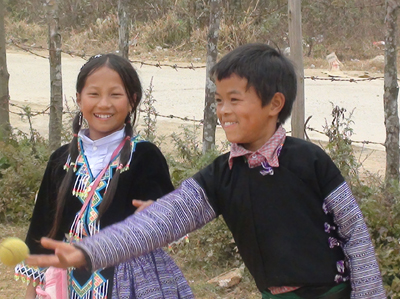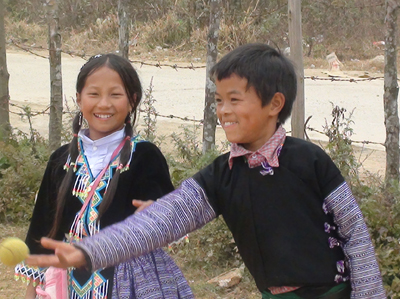
(HBO) - On holidays, Tet or other festivals, Mong ethnic people in Hang Kia commune, Pa Co (Mai Chau) often play a unique game – the tickling game. With this game, from teenagers to children can play all day on the commune’s yards. The game helps people get closer together, they compete with the ingenuity from the boys' callous hands.

The tick of Mong ethnic people is
made of hardwood, and it is rounded. The lower end gradually shrinks into sharp
points, the upper end of the raspberry is like a sliced lemon or it is
hemisphere. When playing tickling, the selected ground must be flat. Players
often use soft strings such as cloth, cotton rope, hemp rope, jute rope, which
is quite firm, tied to a hard tree segment, wich is 1.5 cm in diameter and 35
to 40 cm long. Usually, tickling is a collective game, players are divided into
two groups, each group include from 1 to 2 people or more but not more than 04
people.
Before entering the game, the two
sides simultaneously throw their tickles to the ground to choose the winner and
the loser. The tickle of the loser side stops before the tickle of the
opponent. When choosing the loser, the lost side must knock their tickle down
so that the winner starts to tickle. Then in turn the lost side lets the tickle
rotate first so that each of the winner side can use their tickle to knock on
the rotating tickle of the opponent on the ground, and if someone's tick stops
first, that person's tick loses, and in turn, all of the people in the group,
if they win against the opponent. And vice versa the first group tickle first,
but if the 2nd group still loses, they still have tickle first for the opponent
to continue hitting. This folk game, tickling, requires players to have good
health, eyesight and fast and accurate calculation to hit the rotating tickle
continuously moving position on the ground of the opponent.
Although the folk tickling game
contains the elements intersecting many different ethnic groups, the tickling
game of young Mong ethnic people is sportier and reflects the living of the
community. A folk tickling game has been lost one time, now it has been
restored by Mong ethnic people and it has been brought to the local Homestay
tourism spots, allowing visitors to enjoy an exciting experience of this unique
sport at the high land.
In recent years, Lac Thuy district has paid increasing attention to investing in cultural and sports infrastructure. These grassroots facilities have attracted a large number of residents to participate in recreational and cultural activities, physical training, and community engagement, contributing to the development of cultural life and the local socio-economic growth.
In recent years, the mass physical training and sports (PTS) movement in Hoa Binh province has developed strongly and spread widely. Regardless of age, gender or occupation, people actively participate in physical training, creating a vibrant and enthusiastic sports atmosphere within the community.
Recently, Hoa Binh’s athletes have continued to show strong performances at national-level competitions. Alongside elite athletes, several standout performers have emerged from grassroots sports movements, underlining the province’s growing sports culture.
From April 26 to 27, at the Provincial Sports Arena, the Hoa Binh Provincial Karate Federation organized the 2025 Hoa Binh Open ASUDO Karate Championship.
While modern sports like volleyball and football continue to grow in popularity, traditional folk games and ethnic sports remain a vibrant and essential part of cultural life among the Muong community in Hoa Binh province.
A total of 85 young players from across Hoa Binh province recently participated in the provincial Youth Table Tennis Tournament. Organised by the provincial Centre for Youth Activities, the event was part of activities to celebrate the 94th founding anniversary of the Ho Chi Minh Communist Youth Union (March 26, 1931 – 2025) and the 79th anniversary of Vietnam Sports Day (March 27, 1946 – 2025).


